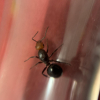I currently have 4 F. subsericea queens, two without any workers and 2 with 5 workers each. I know that F. subsericea can be polygynous, but I'm not sure how. Do you have to mix queens during the founding stage, or will existing colonies accept new queens? If so, I'm going to try to mix the queens with my 5 worker colonies. And if this is possible, how do I mix them? Should I hibernate the together for a couple hours, of allow them to move in by themselves? Thanks in advance!
- Formiculture.com
- Forums
- Gallery
- Members
- Member Map
- Chat
















![[CA] Looking for Formica (can buy/trade) - last post by bmb1bee](https://www.formiculture.com/uploads/profile/photo-thumb-6841.jpg?_r=1649821237)






